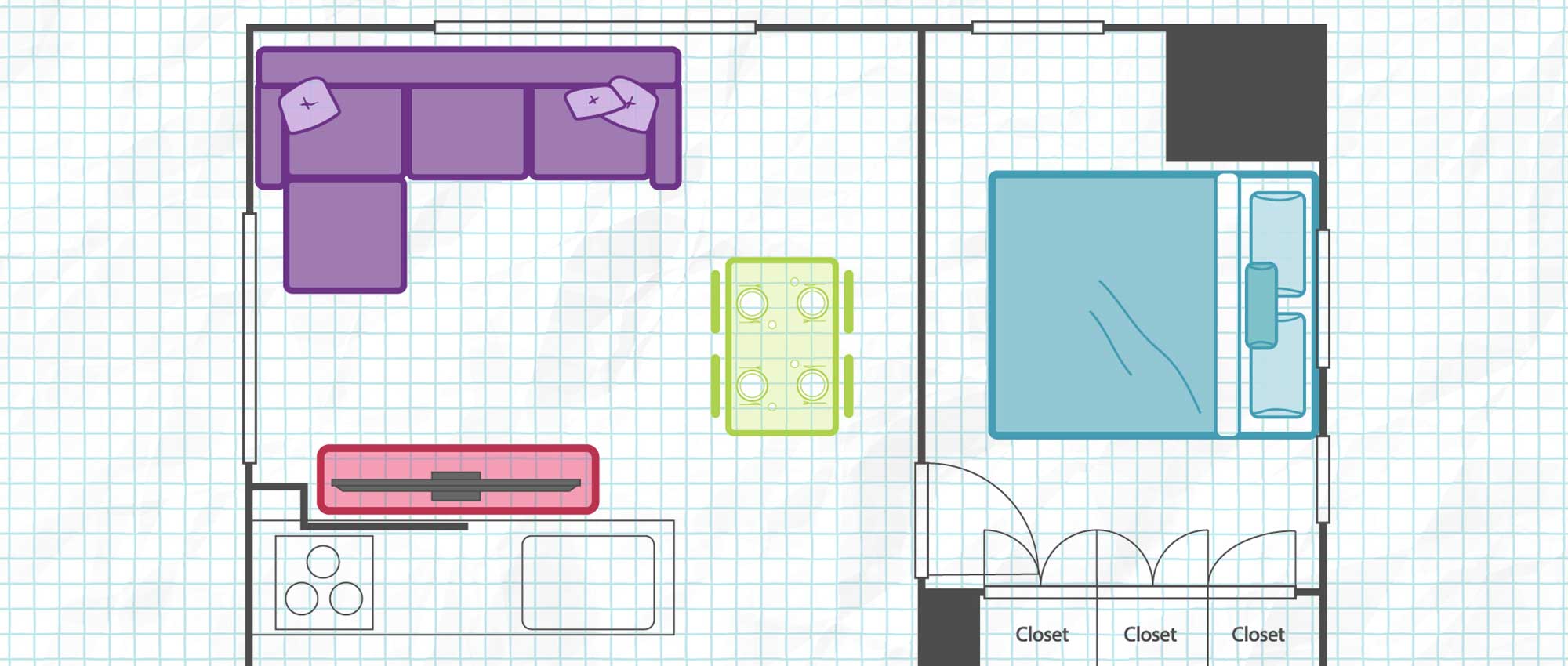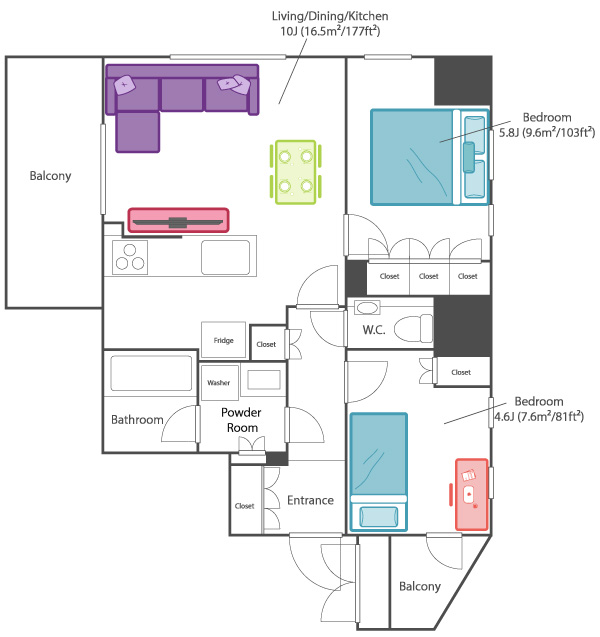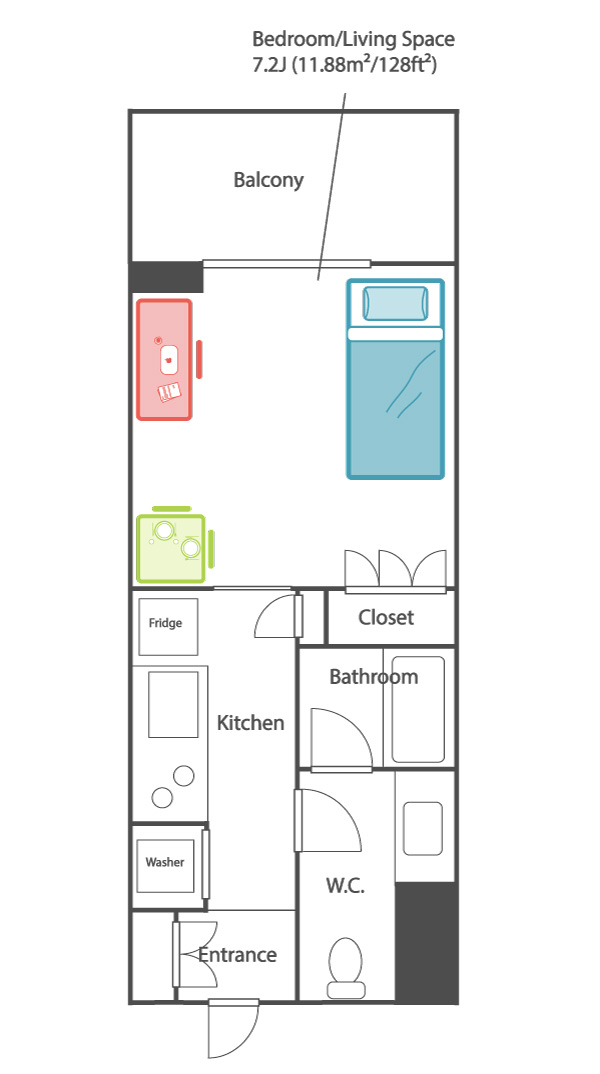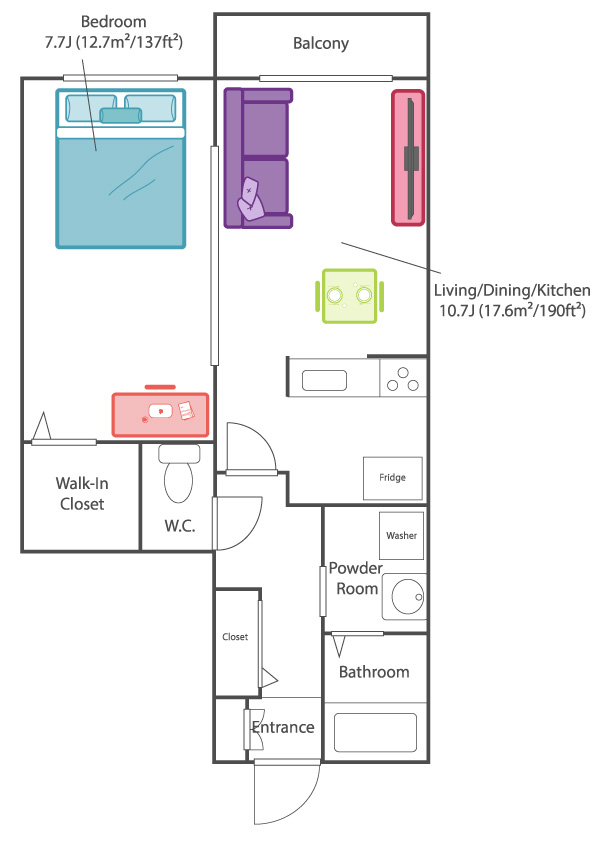
11 Sep Decoding Japanese apartment layouts: Your guide to R, K, DK, LDK and SLDK
Last Modified on September 14th, 2024 at 10:37 am
Category: Housing, Japanese Culture, Living, Renting in Japan, Social & Culture, Uncategorized, Where to Live
When we first started searching for apartments in Japan, we were all a bit overwhelmed by the abbreviations—1R, 1K, DK, LDK. It felt like trying to crack a secret code just to figure out what kind of space we were looking at. After a few confusing apartment viewings, we realized that understanding these terms was essential to finding the right place.
At Apts.jp, we know the process can be confusing, and we’ve even added detailed FAQs to our site to help clarify things. With this guide, we’ll help you get to grips with these terms and take the confusion out of apartment hunting in Japan. By the time you finish reading, you’ll know exactly what those letters and numbers mean and how to use them to find the perfect place to call home. 
The letters – What do R, K, DK, LDK and SLDK mean?
Let’s start with the basics. When you see terms like 1R, 1K, DK, and LDK, you’re looking at a shorthand way to describe the layout of an apartment. Here’s what each one means, including a size guide that we have prepared:
1R: One room, all in one – the studio
What it is: A 1R apartment is essentially a studio. The “R” stands for “Room,” meaning everything—your living space, kitchen, and even your sleeping area—is all in one room.
Size: Typically, these apartments are small, usually between 12ish to 20ish square meters.
Who it’s for: 1R apartments are perfect for singles, students, or anyone on a budget who doesn’t mind living in a compact space.
1K: A little separation – the kitchen studio (view our 1K / studio listings here)
What it is: A 1K apartment gives you a bit more privacy. The “K” stands for “Kitchen,” and in this layout, the kitchen is slightly separate from the main living area.
Size: A bit larger than 1R apartments, 1Ks range from 20 to 25 square meters.
Who it’s for: If you like cooking and want to keep those kitchen smells out of your living space, a 1K might be just what you need – you just need to make sure it has a decent layout.

1DK: Dining-Kitchen – the room for more (view our 1DK listings here)
What it is: DK stands for “Dining-Kitchen.” This means the kitchen is big enough to include a dining area, giving you more space to move around.
Size: 1DK apartments are typically between 25 to 30 square meters.
Who it’s for: If you enjoy having friends over for dinner or just want a bit more room to breathe, a 1DK layout could be a great fit.

1LDK: Living-Dining Kitchen – the home office layout (view our 1LDK listings here)
What it is: LDK is the most spacious of these layouts. The “L” stands for “Living,” so in an LDK, you get a living room, dining area, and kitchen all in one large, open space.
Size: 1LDK apartments usually range from 25 to 40 square meters or more.
Who it’s for: 1LDKs are ideal for couples, small families, or anyone who wants a bit more space to spread out.

The numbers – What Does 1LDK, 2LDK 3LDK Mean?
Now that you know what the letters mean, let’s talk about the numbers. When you see something like 1LDK or 2DK, the number tells you how many separate, livable rooms the apartment has.
1LDK: One bedroom plus a living-dining kitchen area. This means you have one separate bedroom and a combined living, dining, and kitchen space. The separate bedroom can be separated from the living-dining kitchen are by only a sliding door.
2DK: Two bedrooms plus a dining-kitchen area. In this layout, you get two separate rooms for sleeping or other activities, in addition to your dining-kitchen area.
3K: Three bedrooms plus a kitchen area. This layout is ideal for larger families or those who want extra space for an office or guest room.
Remember, the number before the letters represents the total number of bedrooms, while the rest indicates the shared living spaces.
Why did we put liveable in italic?
Well, in Japan, not every room with four walls and a door is considered “livable.” For a room to count as livable—meaning it can be used as a bedroom or living room—it has to meet certain criteria:
- Ventilation: The room must have proper ventilation. This usually means it has a window that opens to the outside, allowing fresh air to circulate.
- Sunlight: The room must receive a certain amount of natural light. A room without adequate sunlight can’t be counted as livable.
- Size: The room should be large enough to function as a bedroom, living room, or similar space. Tiny closets or storage areas don’t count, even if they have a door.
These rules are designed to ensure that all livable rooms in an apartment are comfortable, healthy, and functional.
Okay, but who is ‘Jo’?
Sou desu ne… about Jo and Square Meters
You may notice that some floor plans use “J” (Jo or 帖) as a unit of measurement. This is a traditional way of measuring room size in Japan, based on the size of a tatami mat. Here’s how it works:
- 1J (Jo): One tatami mat, which is approximately 1.653 square meters (17.79 square feet). In Tokyo, the Real Estate Association regulates 1J to be no less than 1.62 square meters.
When apartment hunting, you’ll often see listings that use this measurement, especially for rooms or small areas like kitchens and service rooms.
Wait, what’s the deal with the “S” in apartment listing?
Sometimes, you’ll see an apartment listed as 1SLDK or 2SLDK. So, what does the “S” stand for? It’s a bit of a wildcard—it stands for “Service Room” or “Storage Room.” These rooms aren’t counted as livable because they might be too small, lack ventilation, or not get enough sunlight. But don’t write them off! Service rooms can be incredibly useful:
- Storage: Use it to store your extra belongings, like seasonal clothes or sports equipment.
- Home Office: If it’s big enough, it could make a perfect home office, especially if you don’t need a lot of space. You can even write it off your annual tax 😉
- Guest room: Depending on the size, it could serve as a guest room for short stays.
Service rooms add versatility to an apartment, especially in urban areas where every bit of space counts.
Finding the perfect Japanese apartment
Finding a Japanese apartment doesn’t have to be complicated. By understanding the basic layout terms like 1R, 1K, DK, LDK and SLDK, you can confidently search for an apartment that fits your needs and lifestyle.
Whether you’re a student looking for your first 1R studio, a couple searching for a cozy 1LDK, or a family needing the space of a 3LDK, these terms are your roadmap to finding the right place for you and your family, maybe also for your pet. And remember, we at apts.jp are here to help you every step of the way, from decoding the listings to moving into your new home. Contact us to discuss your upcoming move, or read our other articles on the topic of housing in Japan.